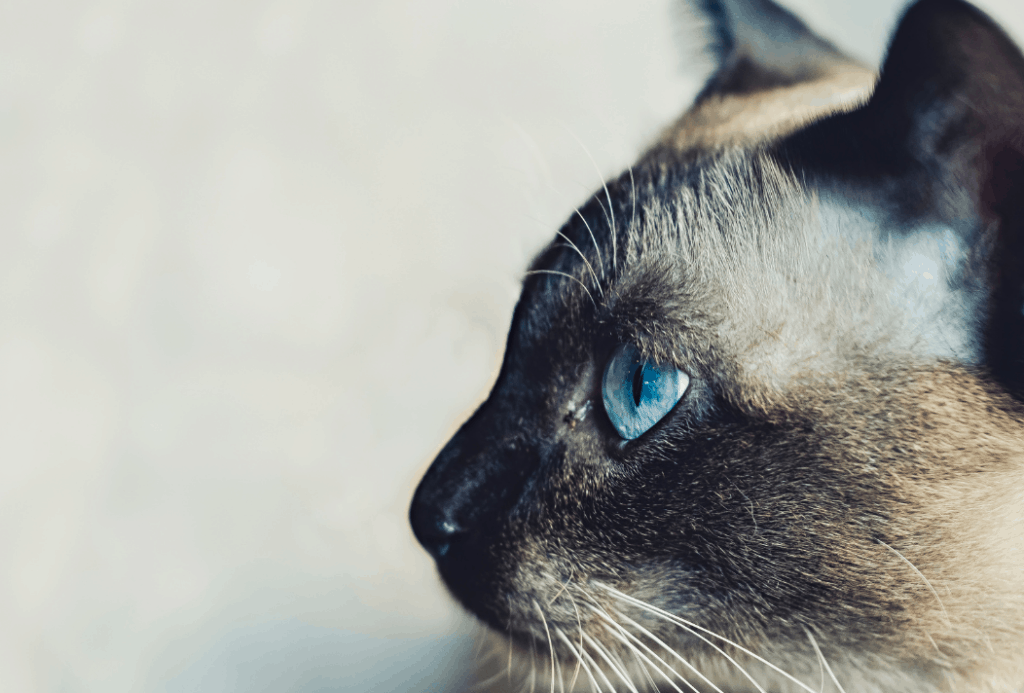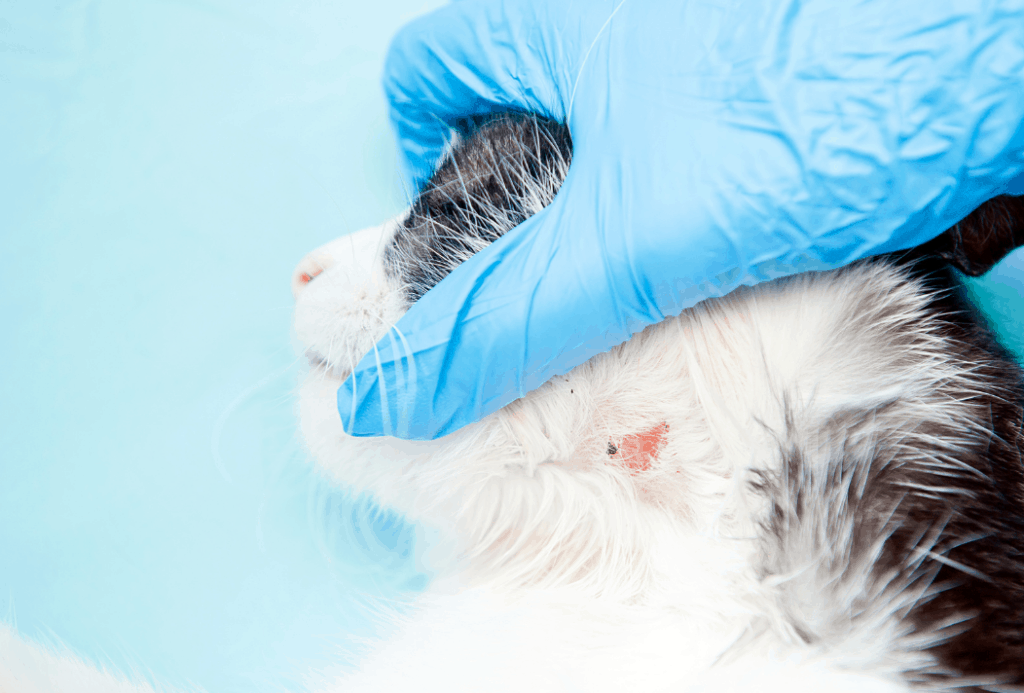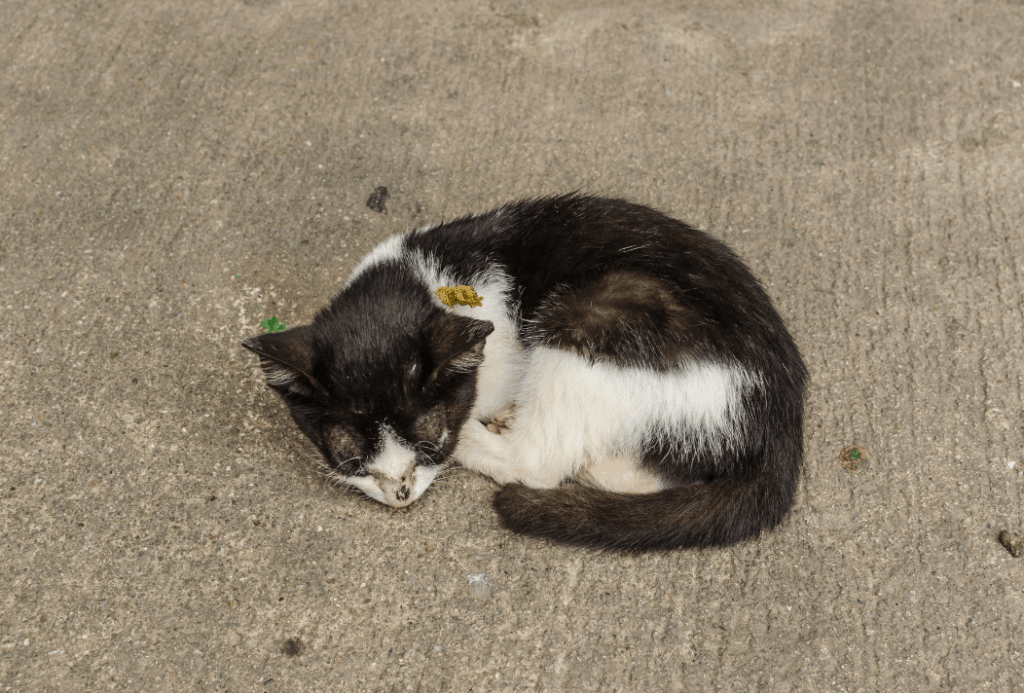Hair Loss in Cats
Cats are meticulous groomers, and with routine coat care plus a high-quality diet, most cats have healthy and shiny coats. But some cats can develop hair loss due to numerous causes, some of which can be difficult to identify.
In this article we look at how hair loss can appear in cats, some of the causes and how to treat it when it happens! Keep reading if your cat is suffering from too much hair loss.
What does hair loss look like in cats?
Cats are almost completely covered in fur from head to toe. There are two spots above their heads and in front of their ears that are naturally thinly-haired in appearance. This is because scent glands from this part of the face are used to send messages via pheromones. Cats like to rub their faces on inanimate objects, causing fur to thin in this area.

Hair loss can occur almost anywhere else on the body.
Most commonly, hair falls out in small patches and can cause an overall moth-eaten appearance. It can occur over the lower back like in cases of flea allergy dermatitis or can occur over the belly when dealing with contact allergies.
Cats with anxiety or behavioral disorders may over-groom themselves and cause broken or barbered hairs. Secondary infections from other causes can result in additional skin lesions besides hair loss (e.g., crusts, redness, flakes, papules, pustules, or bleeding).
What are some causes of hair loss in cats?
There are many different causes for hair loss in cats. Certain cat breeds like the Sphynx cat are born hairless over the whole of their bodies, and they remain hairless all their lives. Since they are at a higher risk of sunburns and for skin disorders like allergies, these kitties need topical moisturizers and sunblock to keep them safe and healthy.
Parasites
External parasites like mites, lice, and fleas can cause inflammation that results in a diseased hair follicle, leading to hair loss. Itchy cats are likely to scratch, lick, or bite themselves, leading to barbered hairs or hair loss altogether.
Food allergies
Cats can develop food allergies and environmental or seasonal allergies, contributing to itchiness, hair loss, and secondary bacterial infections.
Eosinophilic granuloma complex is a condition that causes red, irritated and itchy skin lesions. These can occur in the mouth and elsewhere on the body, especially the chin or lower belly. Hair loss is very likely when the skin is involved. While the exact cause is unknown, it is thought to be triggered by environmental allergies or food allergies.
Skin Disorders
Certain skin disorders are contagious to other pets and to people. Ringworm is a type of fungal infection that can cause round hairless skin lesions. Certain skin mites like scabies are also zoonotic, meaning they can be shared with others. Both ringworm and scabies can cause small, localized hair loss or can cause generalized, widespread hair loss over the entire body.

External Injuries
Hair loss can occur with non-itchy skin conditions. External injuries like cuts and bites can result in localized loss of fur.
Anxiety and stress
When cats are anxious or stressed, they can excessively lick or bite themselves and cause hair loss. This is known as psychogenic alopecia.

Endocrine disorders
Cats can also be affected by endocrine disorders like Cushing’s disease, which is rare compared to how frequently it occurs in dogs. Cushing’s can cause symptoms like thin skin and hair loss. Skin fragility and hair loss can also indicate cancer in some cases.
How is cat hair loss diagnosed?
If you notice that your cat is losing hair, it is important to get them checked out by a veterinarian. Based on your kitty’s clinical signs and history, your vet might talk to you about basic skin testing like a skin impression or a skin scrape.
Skin scrape
These are tests that look for bacteria, yeast, and mites. Fungal culture testing involves collecting a hair sample in order to see if ringworm is present. Fleas can leave evidence of their presence in your cat’s fur, and hair loss is most common over the lower back region.
Blood & urine testing
Blood and urine testing are an important part of a general work up for cats with endocrine disorders. Sometimes, special testing like skin culture or biopsy are necessary to rule out autoimmune problems, eosinophilic granuloma complex, and stubborn bacteria that are resistant to certain antibiotics.
Skin biopsy
Skin biopsies can also rule out more serious problems like skin cancer. If allergies are suspected, intradermal skin testing can help find which allergens are responsible for your cat’s allergies.
How can I treat my cat’s hair loss?
Treatment for hair loss should always be based on the diagnosis. The average general practicing vet can make recommendations based on a working diagnosis.
Itchy kitties may respond to antihistamine or steroid therapy, either topically or systemically. Antibiotics are prescribed for secondary infections.
Some cats may benefit from a bath or a dip in a special product. Lime dip, for example, can help with a number of conditions like mites and ringworm. This is safe for very young patients who cannot take other medications, and it is relatively inexpensive. The only downside is that lime dip is very smelly and tends to stain everything yellow!
Allergic cats may show improvement with a food elimination trial. This involves switching from one diet to another one. The new diet should contain either a novel protein or a hydrolyzed protein. Cats with environmental allergies can benefit from immunotherapy, which is the production of a vaccination based on that particular cat’s allergies. It is meant to help lower the intensity of how the immune system responds to allergens. If this does not help, some cats may require immunosuppressive medication.
There are many different causes for hair loss in cats
All hair loss should be addressed as soon as possible because it can indicate a problem with the cat’s skin. Skin is a natural barrier against bacteria, allergens, and parasites. When it isn’t functioning probably, severe skin infections can occur. Early intervention leads to faster results and happier felines!
Remember that hair loss can take several months to improve in some cases. Mild skin infections and minor wounds can resolve quickly, but deep infections or hair loss due to chronic skin issues can take a long time to improve, especially if it takes a while for long-acting medications to work.
The post Hair Loss in Cats appeared first on VetBabble.




Post a Comment